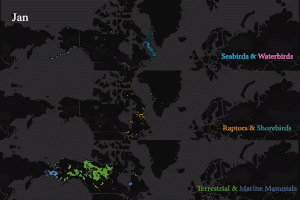
An animated version of this timelapse on the Earth Imaging Journal homepage at www.eijournal shows the movement patterns for various animals (colors indicate different animal types) over the course of a year. Animal migration in the Arctic is highly seasonal, as various species and populations move around in search of food, suitable temperatures, and places to mate and raise their young. (Credit: Roland Kays / North Carolina State Museum of Natural Sciences / Davidson et al.)
For animals in the Arctic, life is a balancing act. Seasonal cues, such as warmer spring temperatures or cooler temperatures in the fall, tell animals when to migrate, when to mate, and when and where to find food. Predators and prey, birds and mammals alike follow this natural schedule, and an overall shift of just a few days or weeks could have unknown impacts on these animals and ecosystems.
These changes in seasonal timing are already starting”although the shifts differ between species and populations”according to a new study published Nov. 5, 2020, in Science that was funded in part by the NASA Arctic-Boreal Vulnerability Experiment (ABoVE). The researchers analyzed data from the Arctic Animal Movement Archive (AAMA), a collection of data from more than 200 research studies tracking nearly a hundred species from 1991 to present, in combination with NASA temperature, rainfall, snowfall and topographic data. They found that Arctic animals' movement patterns are shifting in different ways, which could disrupt entire ecosystems.
The Arctic is showing more extreme indications of climate change, said Gil Bohrer, a professor and environmental engineer at Ohio State University in Columbus. Sea ice is shrinking, rainfall and snowfall are changing, and Arctic tundra is turning green in some places and brown in others. Arctic animals are responding to these changes, they're responding quickly, and that response is not equal, said Bohrer.

